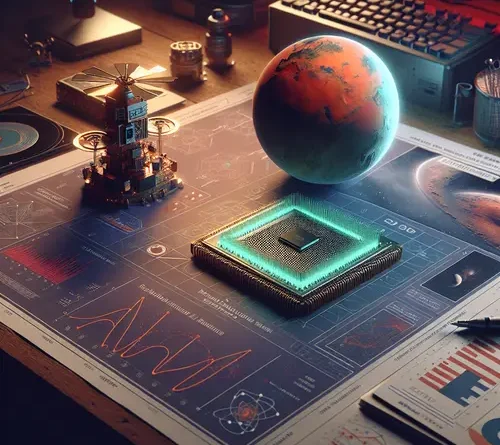Radiation-Hardened AI Hardware for Long-Term Mars Deployment: Challenges, Solutions, and First Principles Analysis
Abstract
This paper explores the development of radiation-hardened artificial intelligence (AI) hardware essential for long-term human colonization of Mars. Drawing from first principles reasoning, we deconstruct the fundamental challenges posed by the Martian radiation environment and propose engineered solutions to ensure reliable AI operation in habitat construction, resource management, and autonomous systems. Key innovations include multi-layer shielding, fault-tolerant architectures, and adaptive AI algorithms. We identify areas requiring further research and reference ongoing efforts in space-grade electronics.
Introduction
The colonization of Mars demands robust computational infrastructure capable of withstanding the planet’s harsh radiation environment, far more intense than Earth’s due to the absence of a global magnetic field and thin atmosphere. AI hardware will underpin critical functions such as autonomous robotic operations and life support systems. This work builds on foundational concepts in autonomous robotic construction on Mars, emphasizing hardware resilience for sustained deployment.
From first principles, radiation exposure arises from galactic cosmic rays (GCRs) and solar particle events (SPEs), which can induce single-event upsets (SEUs) in electronics, leading to data corruption or hardware failure. Without mitigation, AI systems risk operational downtime, endangering missions. Our analysis prioritizes minimizing these risks through physics-based design.
The Martian Radiation Environment: A First Principles Breakdown
Breaking down to fundamentals: Mars receives approximately 200-300 millisieverts (mSv) of radiation per year on the surface, compared to Earth’s 2-3 mSv, primarily from GCRs (high-energy protons and heavy ions) and SPEs during solar storms. These particles penetrate materials, ionizing atoms and generating secondary radiation.
Key challenges for AI hardware:
- Single-Event Effects (SEEs): SEUs flip bits in memory; single-event latchups (SELs) cause short circuits.
- Total Ionizing Dose (TID): Cumulative degradation of semiconductors over years.
- Thermal and Power Constraints: Mars’ temperature swings (-60°C to 20°C) compound radiation-induced failures, while power must be sourced from solar or nuclear means.
Sources: NASA’s Mars radiation data from the Curiosity rover (NASA MSL Radiation Assessment); radiation modeling from the European Space Agency (ESA Radiation Shielding).
Proposed Solutions: Engineering from First Principles
Using first principles, we redesign AI hardware by isolating core requirements: (1) detect and correct errors, (2) shield vulnerable components, (3) ensure redundancy, and (4) optimize for low-power, long-duration operation.
Shielding Strategies
Fundamental physics dictates that dense materials absorb radiation. Propose polyethylene-based shielding (rich in hydrogen to fragment heavy ions) combined with regolith burial for habitats. For compact AI nodes, integrate 5-10 cm of water-equivalent shielding around processors, reducing TID by 50-70%. Hybrid solutions: Embed AI in habitat walls using Martian regolith (iron-rich for gamma absorption).
Reference: Studies on polyethylene shielding (NASA Technical Report on Polyethylene Shielding).
Fault-Tolerant Hardware Architectures
Deconstruct AI reliability: Use radiation-hardened (rad-hard) silicon-on-insulator (SOI) chips, which isolate transistors to prevent charge collection. Propose triple modular redundancy (TMR) for critical AI modules, where three identical processors vote on outputs to correct SEUs in real-time. For neural networks, implement error-correcting codes (ECC) in memory and adaptive learning to reroute around degraded paths.
Power efficiency from first principles: Leverage neuromorphic chips mimicking brain efficiency, reducing power draw to <1W per core while maintaining AI inference speeds. Example: IBM’s TrueNorth-inspired designs adapted for space.
Sources: Rad-hard SOI technology (NASA Goddard Rad-Hard Electronics); TMR applications (IEEE Paper on TMR for Space AI).
Software and AI Adaptations
Hardware alone insufficient; integrate radiation-aware AI. From basics: Monitor radiation flux via onboard sensors and dynamically scale AI operations (e.g., reduce precision during SPEs). Use machine learning for predictive maintenance, forecasting failures based on dose accumulation.
Deployment scenario: AI hardware in rovers and habitats for 5-10 year missions, supporting self-repair via 3D-printed spares.
Challenges and Areas for Further Research
While proposed solutions mitigate known risks, gaps remain. Long-term TID effects on emerging AI hardware (e.g., quantum or optical computing) are untested in Mars analogs. Integration with in-situ resource utilization (ISRU) for self-manufactured shielding needs validation.
Identified items requiring further development:
- Scalable production of rad-hard neuromorphic chips for AI workloads.
- Real-time radiation forecasting models tailored to Mars’ orbit.
- Hybrid organic-inorganic shielding using Martian materials.
Conclusion
Radiation-hardened AI hardware is pivotal for Mars colonization, enabling autonomous, resilient systems. By reasoning from first principles, we outline a path to deployment, urging accelerated R&D to bridge remaining gaps. Future work will simulate these designs in high-fidelity environments.
